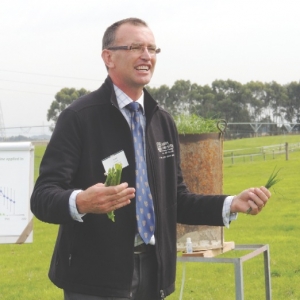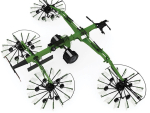“There is some wriggle room in how we manage winter crops,” Dairy NZ principal scientist David Chapman told the Lincoln University Dairy Farm focus day.
Lincoln University’s Grant Edwards went on to explain fodder beet’s very low crude protein content means urine nitrogen content of cows grazing the crop is “extremely low”, even where the diet is supplemented with grass silage.
“It’s more like a sheep urine patch in terms of nitrogen than a typical grazing cow’s urine patch,” he commented.
However, fodder beet’s typically high yields/ha mean high stocking rates and consequent high number of urine patches/ha, eroding that environmental advantage.
“The urine’s covering the paddock something like one and a half times and the higher the yield the higher those losses will be. What saves fodder beet from having a high environmental footprint, because of the high stocking rates on it, is that low nitrogen content.”
The net result measured in lysimeters by Lincoln University in wintering paddocks is typically 75-85kgN/ha lost under kale and 55-60kgN/ha under fodder beet.
While some dairy farmers might not worry about losses under crop because they happen on someone else’s farm, Chapman says understanding how dairy farming systems impact nutrient losses across catchments is important.
Taking a holistic view also brings the apparently high production/ha of high input systems into line with all grass because the area used to grow inputs such as grain off the milking platform dilutes the milk production/ha from it.
Edwards also talked about pasture composition as a tool to boost production and, potentially, cut nutrient losses.
Diverse pasture mixes including chicory and plantain with standard ryegrass and white clover swards on the research farm have, to date, yielded more drymatter than straight ryegrass clover and are of higher quality, resulting in 5% higher milk production/cow. Meanwhile the urine nitrogen concentration of cows on diverse pasture was at least 40% lower (see table), with slightly higher volume, likely meaning a lower intensity of nitrogen deposition in each urine patch.
“The amount of nitrogen falling in a urine patch is a key driver for nitrate leaching. We see these pastures as a tool to reduce that.”
And while the data Edwards presented was from Lincoln, data from similar work in Waikato is producing very similar results, he said.
As yet, Overseer can’t model such pasture composition differences but the data is being supplied to the programme’s keepers with a view to it being integrated in the future, he added.
Unfortunately the news isn’t so good for lucerne, at least from a nitrogen loss point of view. The crop is quite justifiably called the “king of forages” for its production, typically outyielding ryegrass whether dryland or irrigated. Milk yield per cow off the crop is also 7% higher than off straight ryegrass, but urine nitrogen concentration’s been found to be 24-74% higher, depending on season. “We’re getting a really high nitrogen urine patch…. Potentially that’s a risk.”
That appears to be factored into the current Overseer model as a farmer present noted that grazing his cows on lucerne in the summer puts his system “through the roof” on nitrogen loss.
Edwards said more work is planned to check the losses under lucerne as it may be that the plant’s ability to take water from great depth means it can also mop up nitrogen from depth, nitrogen that is currently assumed to be a loss. “We do know it is one of the best plants to take toxic substances out from deep in the soil.”









